
Learn
A tire’s sidewall is pretty much what it sounds like – the outer and inner “walls” on the sides of a tire, if facing a tire on its side. Every sidewall has its own unique information that is divided into four main sections:
1. TIRE SPECS
This describes the fundamental characteristics of your tire. Size, construction, speed rating and more.
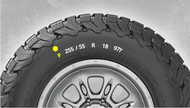
Tire type
This designates the type of vehicle the tire fits. P is for passenger metric. Other letters are LT (for light truck), T (for temporary spare) and ST (for special trailers). If your tire has no letter, it signifies that your tire is a euro “metric” size.
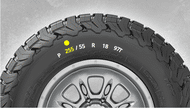
Tire Width
Also called Section Width, this is the width of the tire (or thickness) in millimeters, if measured from a tire’s widest point of its outer sidewall to the widest point of its inner sidewall. Why millimeters? It originated in Europe, which uses the metric system.
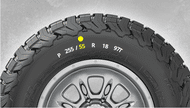
Ratio
This identifies the tire’s aspect ratio, which is the relationship of the tire’s sidewall height to the tire’s width. In this example, the sidewall height of the tire is 55% of its width. The lower the ratio, the smaller the sidewall height, which means better cornering, but a rougher ride.
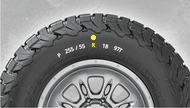
Construction
This is the tire’s internal construction, which is “radial.” Almost every tire on the road has radial construction, which means the cords of the carcass plies inside the tire “radiate” directly across from one side of the tire to the other. Other letters used are D, for diagonal construction, and B, for belted.
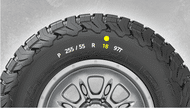
Wheel Diameter
This number (in inches) indicates that the tire is designed to fit on a wheel with a 18-inch diameter.
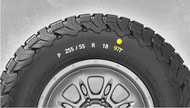
Load Index
This indicates how much weight the tire is certified to carry at maximum safe inflation. It doesn’t mean 97 pounds, because it’s actually an assigned value that corresponds with its “actual” load capacity found on a load index chart. If you look up 97 on the chart, you’ll find 1,609 pounds. (To see the load index chart on the Tire Speed Ratings & Tread Life page,
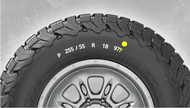
Speed Rating
This indicates the maximum safe speed at which a tire is certified to carry a load under specified conditions. Speed ratings range from A (lowest) to Y (highest), with one exception: H falls between U and V. To find the maximum speed for your tire, refer to the speed rating chart*. Exceeding the lawful speed limit is neither recommended nor endorsed.
2. DEPARTMENT OF TRANSPORTATION SAFETY CODE
This assures that your tire complies with all Department of Transportation (DOT) safety standards. After the DOT insignia is your tire’s identification number, which begins with the tire’s manufacturer and plant code where the tire was manufactured (two numbers or letters). The ninth and tenth characters tell the week the tire was manufactured. The final number(s) signifies the year the tire was manufactured.
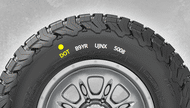
DOT
Department of Transportation Safety Code
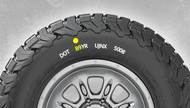
B9
Tire's manufacturer and plant code
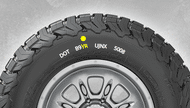
YR
Denotes tire size.
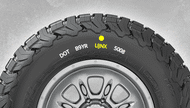
UJNX
Optional characters that identify brand and other significant characteristics of the tire
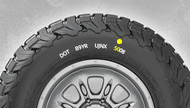
50
Denotes week the tire was produced
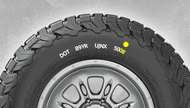
08
Denotes year the tire was manufactured.
3. UTQG CODE
The Uniform Tire Quality Grading (UTQG) was established by the National Highway Traffic Safety Administration (NHTSA) to test tires following government prescribed test methods and then grade each tire on three main components:
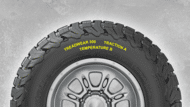
- Treadwear: This is the wear rate of the tire, comparable only to other tires within a tire manufacturer’s line. 100 is the baseline grade. Therefore a tire with 200 would theoretically last twice as long on the government’s course compared to a tire with 100.
- Traction: Traction grades are AA, A, B and C (with AA being the highest grade). They represent the tire’s ability to stop straight on wet pavement as measure on a specified government track. Any tire rated under C is considered unacceptable for road travel.
- Temperature: The temperature grades, from highest to lowest, are A, B and C. These represent the tire’s ability to dissipate heat under controlled indoor test conditions. Any tire rated below C is considered unacceptable.
4. ICONS
Some tires have unique benefits, as showcased with specific icons. For example, a Mountain Snowflake symbol tells you that the tire meets or exceeds industry-established snow traction performance requirements.
